Optimization Study on a Novel High-Speed Oil-Free Centrifugal Water Pump with Hydrodynamic Bearings
Abstract
:1. Introduction
2. Numerical Model
2.1. Physical Model
2.2. Meshing
2.3. Control Equation and Solution
3. Experimental Study
3.1. Test Rig
3.2. Experimental Results
4. Results and Discussion
4.1. Validation of Numerical Model
4.2. Effect of Hydrodynamic Bearings
4.3. Effect of Blade Number of Impeller
4.4. Effect of Blade Number of Stay Vane
4.5. Characteristic of Internal Flow Field
4.5.1. Velocity Streamline under Different Cases
4.5.2. Static Pressure Distribution under Different Cases
5. Conclusions
- The hydrodynamic bearings can well support the high-speed operation of the centrifugal pump. The balance of the axial force and the bearing capacity during the operation can lead to the axial displacement of the impeller, which is less than 15 μm. The change of the head caused by the axial displacement is within 0.39 m.
- A larger number of impeller blades leads to an increase in the head with a decreasing amplitude. In addition, it has a favorable effect on the efficiency of the high-speed pump first and then decreases the efficiency gradually.
- The increase first and then the decrease of the head and the efficiency are controlled by increasing the stay vane blade number.
- The head and efficiency can reach 26.3 m and 30.8% when the impeller and the stay vane are perfectly matched. The blade number has a significant impact on the performance of the high-speed centrifugal pump.
Author Contributions
Funding
Conflicts of Interest
Nomenclatures
| ρ/kg·m−3 | Density | D/mm | Diameter |
| P/bar | Pressure | / | Blade angle |
| n/rpm | Rotational speed | Q/m3·h−1 | Flow rate |
| H/m | Head | W/W | Power |
| b/mm | Passage width | g/m·s−2 | Gravity |
| Z/(-) | Number of blades | v/m·s−1 | Velocity magnitude |
| k/m2·s−2 | Turbulent kinetic energy | f/(-) | Friction factor |
| rpm/(-) | Revolution per minute | ψ/(-) | Excretion coefficient |
| /(-) | Slip coefficient | Y | Area ratio |
| h(μm) | Liquid film thickness | ||
| Subscription | |||
| 1 | Impeller Inlet | 2 | Impeller Outlet |
| 3 | Stay vane inlet | 4 | Stay vane outlet |
| hyd | Hydraulic components | t | Total |
| thr | Throat | dif | Diffuser |
References
- Nemdili, A.; Hellmann, D.H. The requirements to successful centrifugal pump application for desalination and power plant processes. Desalination 1999, 126, 199–205. [Google Scholar] [CrossRef]
- Cirino, M.; Friedrich, K.; Pipes R, B. The effect of fiber orientation on the abrasive wear behavior of polymer composite materials. Wear 1988, 121, 127–141. [Google Scholar] [CrossRef]
- Nair, V.P.S.; Nair, K.P. Finite element analysis of elastohydrodynamic circular journal bearing with micropolar lubricants. Finite Elem. Anal. Des. 2004, 41, 75–89. [Google Scholar] [CrossRef]
- Kumar, V.; Sharma, S.C.; Jain, S.C. On the restrictor design parameter of hybrid journal bearing for optimum rotordynamic coefficients. Tribol. Int. 2006, 39, 356–368. [Google Scholar] [CrossRef]
- Prehn, H.; Friedrich, F. Sliding wear performance of polymer composites under abrasive and water lubricated conditions for pump applications. Wear 2005, 259, 693–696. [Google Scholar] [CrossRef]
- Litwin, W. Influence of surface roughness topography on properties of water-lubricated polymer bearings: Experimental research. Tribol. Trans. 2011, 54, 351–361. [Google Scholar] [CrossRef]
- Gerasimov, V.S.; Nikiforov, S.A.; Pautov, Y.M.; Snetkov, V.G.; Fedorov, G.P.; Mikhailov, A.D. Development of high-load water-lubricated radial-axial bearings for electric-pump units in the first loop of a nuclear power plant. At. Energy 2000, 89, 1027–1030. [Google Scholar] [CrossRef]
- Nakata, K. Rubber bearing apply for pumps. Pump Inf. 1980, 1, 28–32. [Google Scholar]
- Memardezfouli, M.; Nourbakhsh, A. Experimental investigation of slip factors in centrifugal pumps. Exp. Therm. Fluid Sci. 2009, 33, 938–945. [Google Scholar] [CrossRef]
- Andenson, H. The area ration system. World Pump. 1984, 6, 34–38. [Google Scholar]
- Iqbal, M.; Wasy, A.; Batani, D.; Rashid, H.; Lodhi, M.A.K. Design modification in rotor blade of turbo molecular pump. Nucl. Inst. Methods Phys. Res. A 2012, 678, 88–90. [Google Scholar] [CrossRef]
- Curtis, E.M.; Hodson, H.P.; Banieghbal, M.R.; Denton, J.D.; Howell, R.J.; Harvey, N.W. Development of blade profiles for low-pressure turbine applications. J. Turbomach. 1997, 119, 531. [Google Scholar] [CrossRef]
- Muggli, F.A.; Holbein, P.; Dupont, P. CFD calculation of a mixed flow pump characteristic from shutoff to maximum flow. J. Fluids Eng. 2002, 124, 132–141. [Google Scholar] [CrossRef]
- Sriveerakul, T.; Aphornratana, S.; Chunnanond, K. Performance prediction of steam ejector using computational fluid dynamics: Part 1. Validation of the CFD results. Int. J. Therm. Sci. 2007, 46, 812–822. [Google Scholar] [CrossRef]
- Hornsby, C. CFD—Driving pump design forward. World Pumps 2002, 431, 18–22. [Google Scholar] [CrossRef]
- Jeon, Y.; Choi, J.; Cho, K.; Kim, S. Characteristics of tunnel fires. Concr. Struct. 2011, 6, 95–124. [Google Scholar]
- Kim, S.; Choi, Y.; Lee, K. Design optimization of mixed-flow pump impellers and diffusers in a fixed meridional shape. AIP Conf. 2010. [Google Scholar]
- Singh, P.; Nestmann, F. Experimental investigation of the influence of blade height and blade number on the performance of low head axial flow turbines. Renew. Energy 2011, 36, 272–281. [Google Scholar] [CrossRef]
- Knierim, C.; Baumgarten, S.; Fritz, J. Design process for an advanced reactor coolant pump for a 1400 MW nuclear power plant. In Proceedings of the FEDSM2005:2005ASME Fluids Engineering Divisions Summer Meeting and Exhibition, Houston, TX, USA, 19–23 June 2005. [Google Scholar]
- Chakrabort, S.; Choudhuri, K.; Dutta, P. Performance prediction of centrifugal pumps with variations of blade number. J. Sci. Ind. Res. 2013, 72, 378. [Google Scholar]
- Krain, H. Experimental observation of the flow in impellers and diffusers. In Von Karman Inst for Fluid Dyn Flow in Centrifugal Compressors; von Karman Institute for Fluid Dynamics: Saint-Genesius-Rode, Belgium, 1984. [Google Scholar]
- Jafarzadeh, B.; Hajari, A.; Alishahi, M.M. The flow simulation of a low-specific-speed high-speed centrifugal pump. Appl. Math. Model. 2011, 35, 242–249. [Google Scholar] [CrossRef]
- Li, X.H.; Zhang, S.J.; Zhu, B.L.; Hu, Q.B. The study of the κ-ε turbulence model for numerical simulation of centrifugal pump. Int. Conf. Comput. Aided Ind. Des. Concept. Des. 2006, 1–5. [Google Scholar]
- ANSYS Fluent Theory Guide; ANSYS Inc.: Canonsburg, PA, USA, 2015.
- Christos, B.; George, T. Accurate explicit equations for the determination of pipe diameters. Int. J. Hydraul. Eng. 2013, 2, 115–120. [Google Scholar]
- Gülich, J.F. Centrifugal Pumps; Springer: Berlin/Heidelberg, Germany, 2010. [Google Scholar]

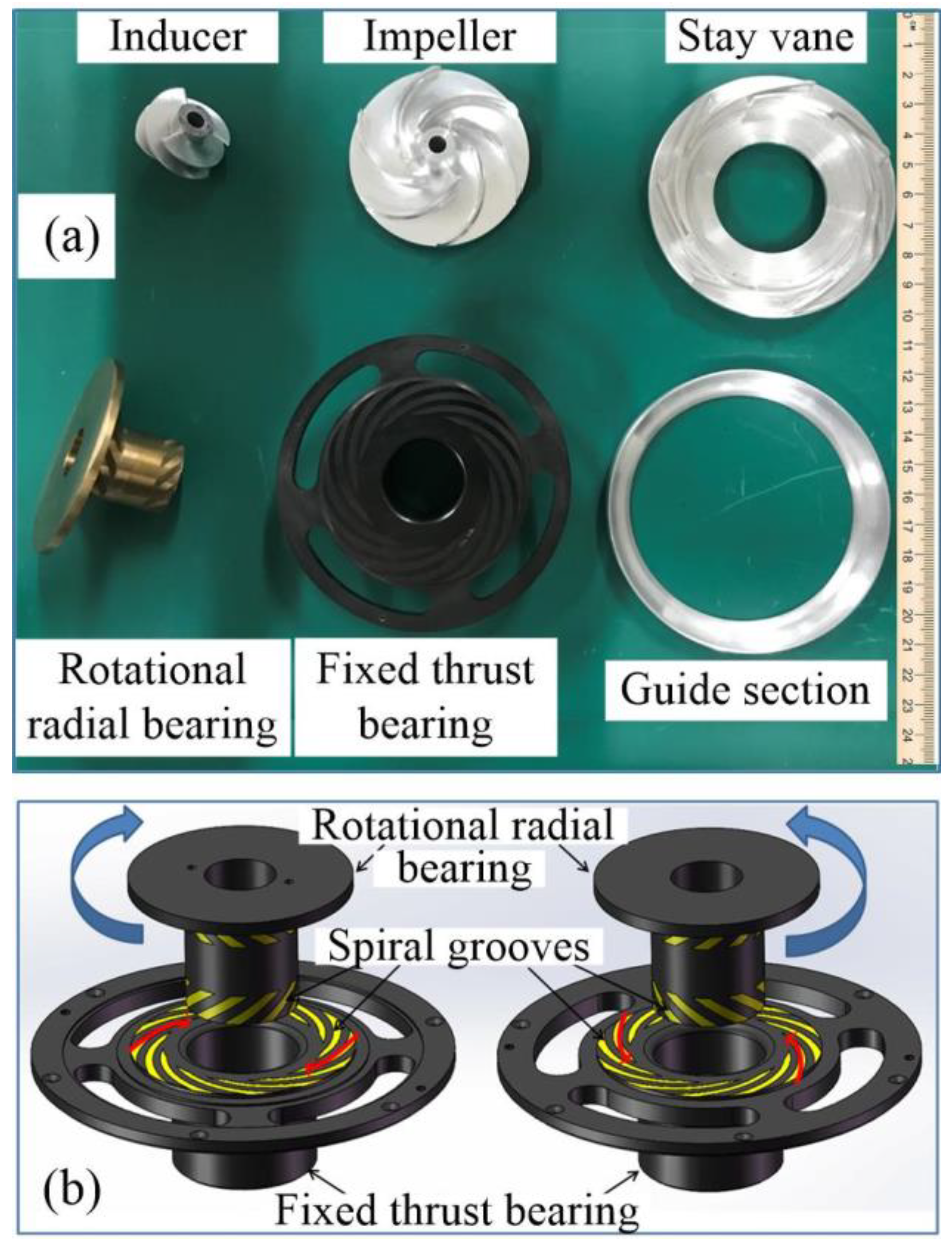



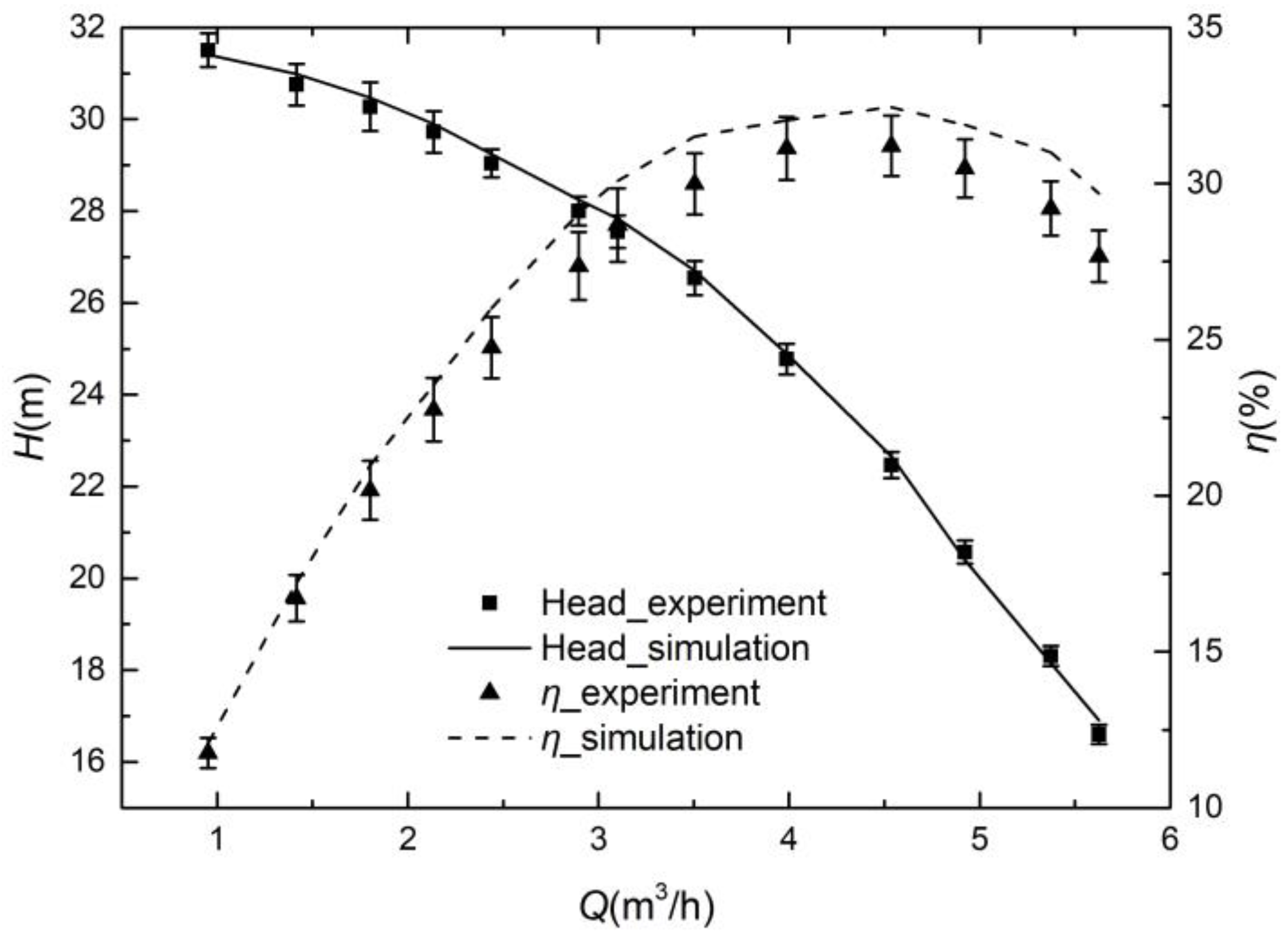
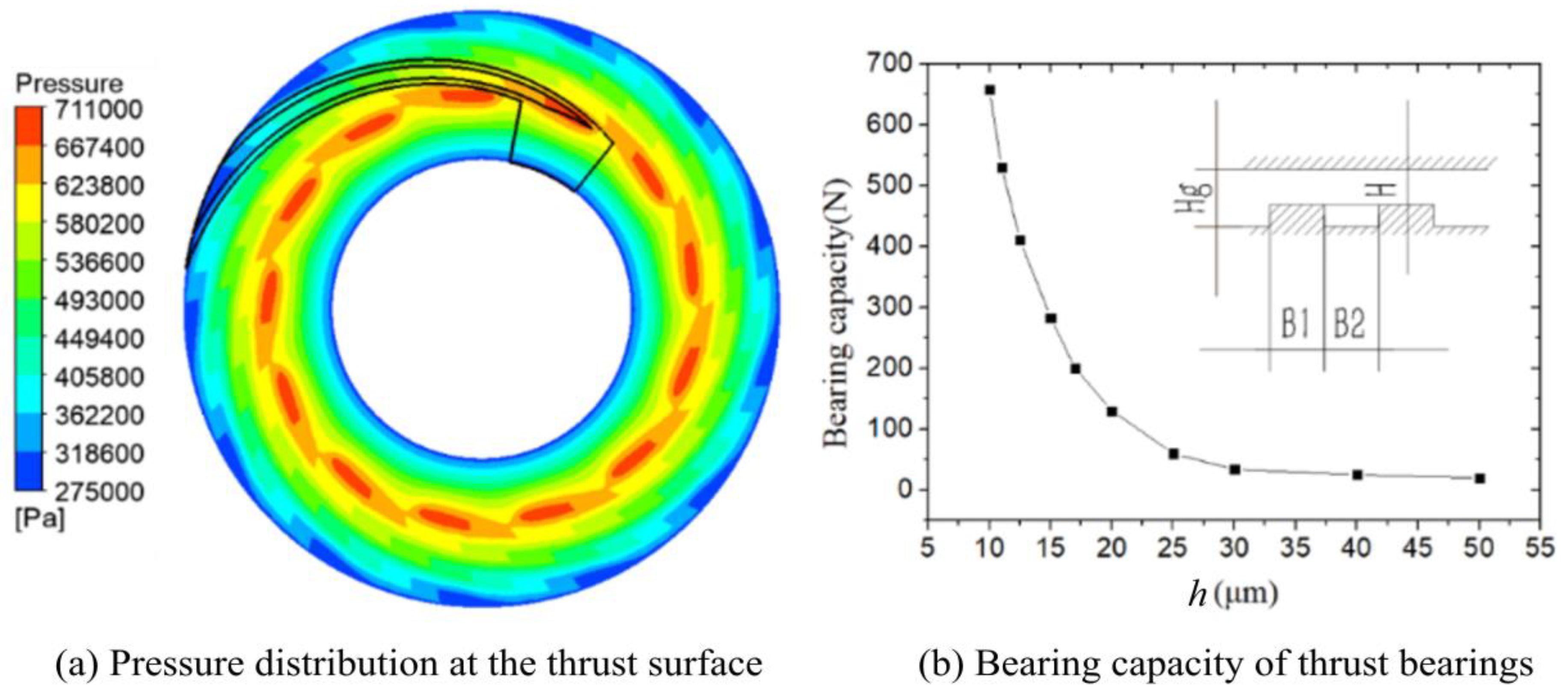

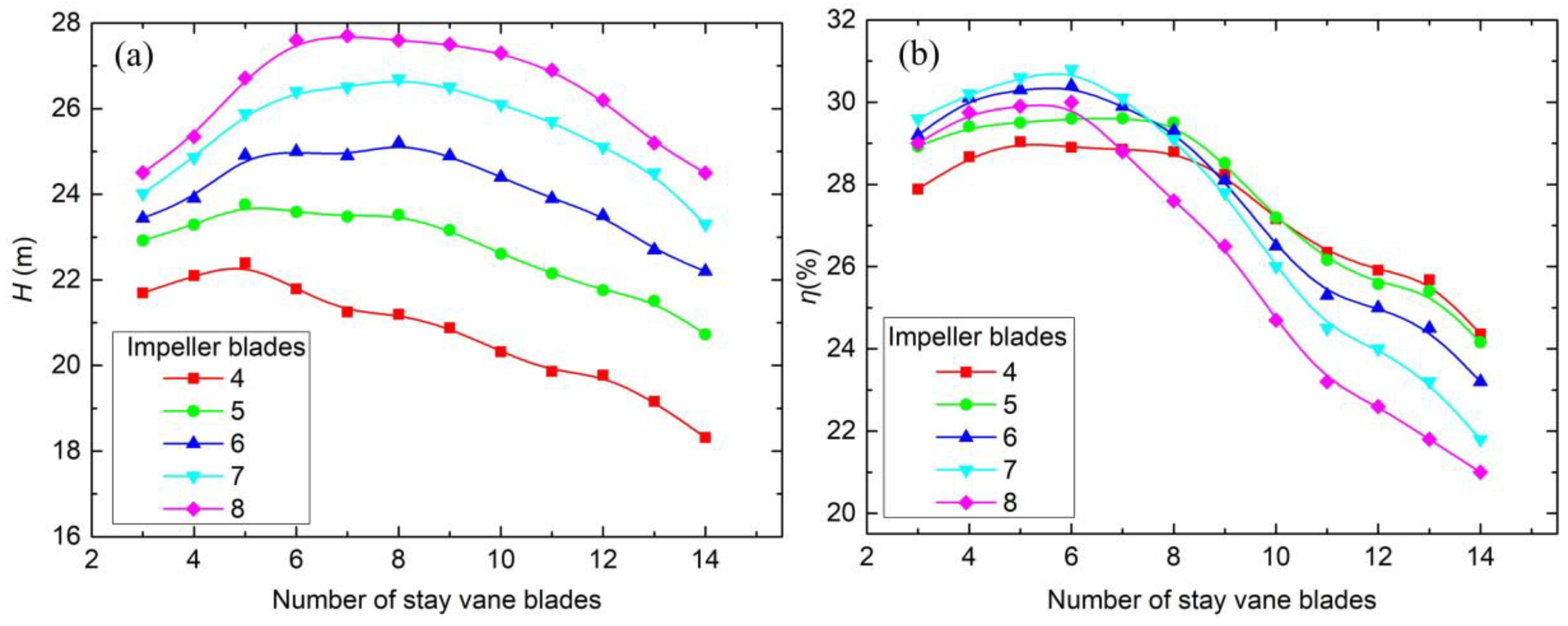
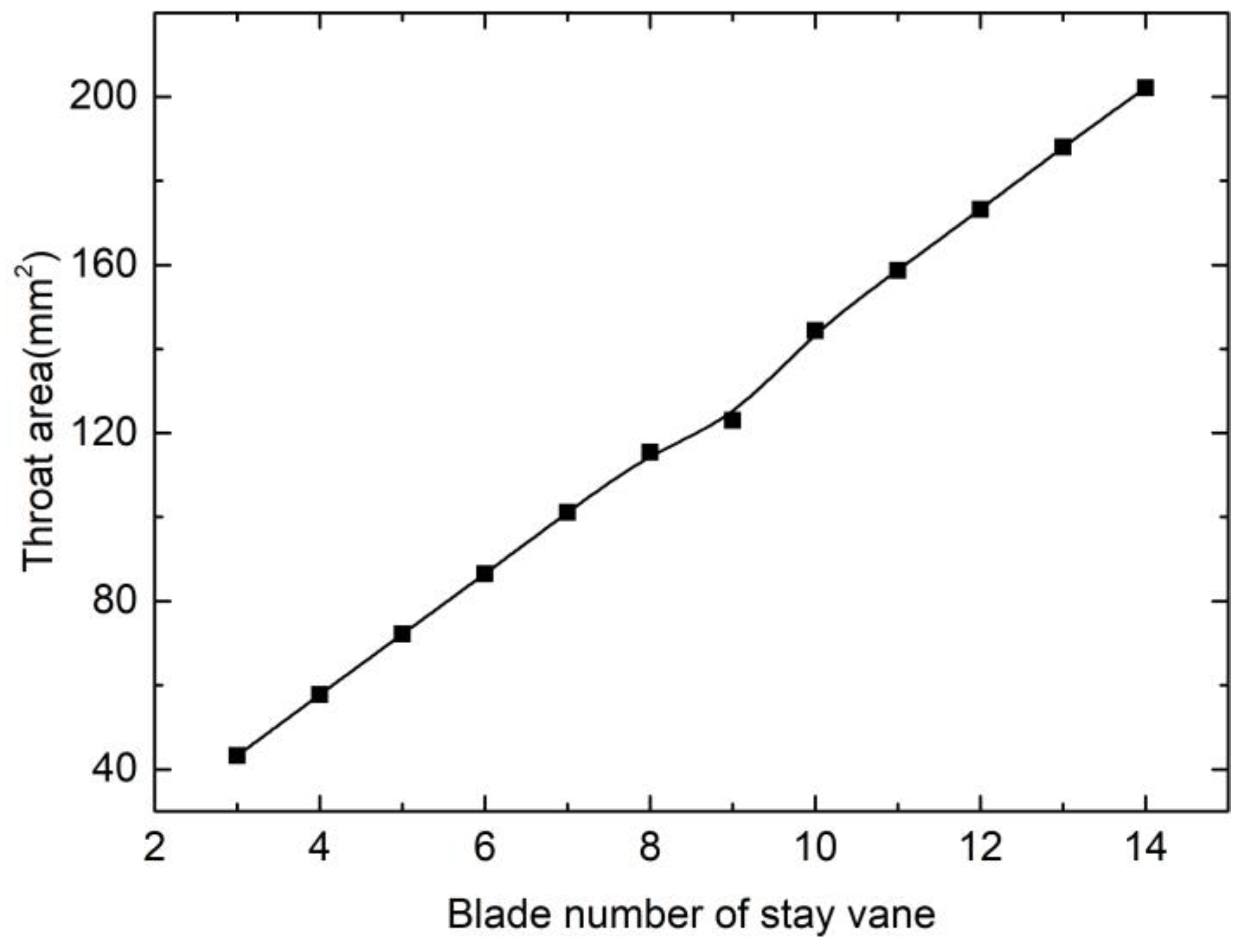
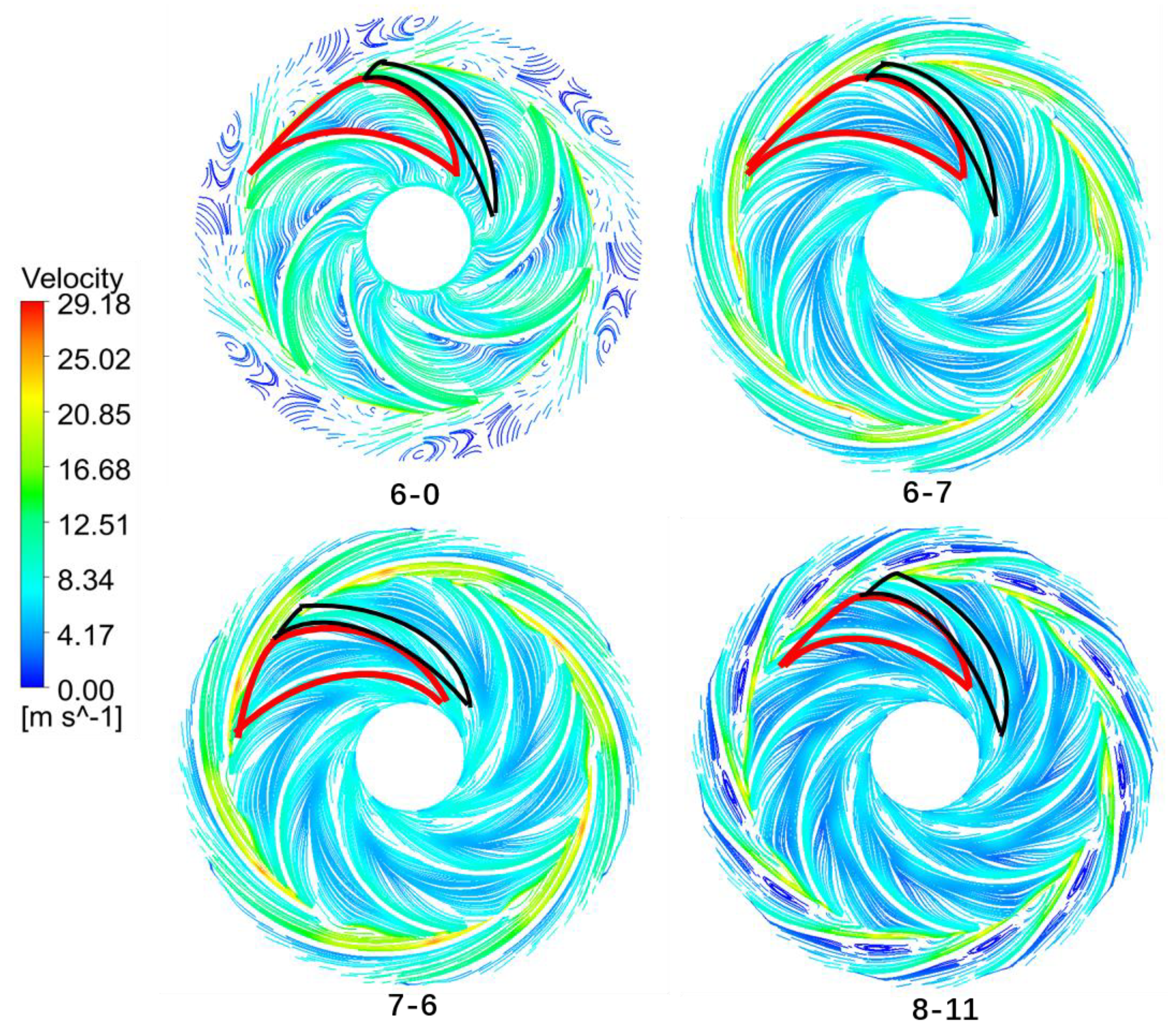




| Parameter | Symbol | Value |
|---|---|---|
| Flow rate | Q | 4 m3·h−1 |
| Head | H | 25 m |
| Rotational speed | n | 7500 rpm |
| Impeller inlet diameter | D1 | 27.2 mm |
| Impeller outlet diameter | D2 | 64.0 mm |
| Impeller Blade outlet width | b2 | 3.8 mm |
| Impeller Outlet Blade angle | 20° | |
| Vane inlet diameter | D3 | 65.0 mm |
| Vane Outlet diameter | D4 | 82.0 mm |
| Vane Outlet Blade angle | 5.8° |
| Parameter | Coarse (2,087,663) | Medium (4,569,430) | Fine (6,857,792) |
| Head at BEP(m) | 24.11 | 25.02 | 25.18 |
| Q (m3·h−1) | Hhyd (m) | Ht (m) | Wi (W) | |||
|---|---|---|---|---|---|---|
| 5.63 | 16.60 | 14.57 | 919 | 27.67% | 24.29% | 3.38% |
| 5.37 | 18.31 | 16.29 | 917 | 29.20% | 25.99% | 3.21% |
| 4.92 | 20.57 | 18.61 | 904 | 30.49% | 27.58% | 2.91% |
| 4.54 | 22.47 | 20.64 | 889 | 31.21% | 28.67% | 2.54% |
| 3.99 | 24.78 | 23.31 | 864 | 31.13% | 29.29% | 1.84% |
| 3.50 | 26.54 | 25.02 | 844 | 29.99% | 28.27% | 1.72% |
| 3.10 | 27.55 | 25.99 | 811 | 28.67% | 27.05% | 1.62% |
| 2.90 | 28.00 | 26.69 | 807 | 27.36% | 26.08% | 1.28% |
| 2.44 | 29.04 | 28.27 | 779 | 24.75% | 24.09% | 0.66% |
| 2.14 | 29.72 | 29.08 | 759 | 22.75% | 22.26% | 0.49% |
| 1.80 | 30.28 | 29.78 | 736 | 20.17% | 19.84% | 0.33% |
| 1.42 | 30.76 | 30.46 | 709 | 16.71% | 16.55% | 0.16% |
| 0.95 | 31.51 | 30.76 | 694 | 11.76% | 11.48% | 0.28% |
| Position | Front | Rear | Left | Right | Average | |
| Noise (dB) | 53.96 | 54.01 | 53.79 | 53.81 | 53.89 | |
| Case | Blade Number of Impeller | Blade Number of Stay Vane | Head (m) | Efficiency (%) |
|---|---|---|---|---|
| 6-0 | 6 | 0 | 18.35 | 17.4 |
| 6-7 | 6 | 7 | 25.18 | 29.4 |
| 7-6 | 7 | 6 | 26.31 | 30.8 |
| 8-11 | 8 | 11 | 26.62 | 23.9 |
© 2019 by the authors. Licensee MDPI, Basel, Switzerland. This article is an open access article distributed under the terms and conditions of the Creative Commons Attribution (CC BY) license (http://creativecommons.org/licenses/by/4.0/).
Share and Cite
Xue, R.; Cai, Y.; Fang, X.; Chen, L.; Zhang, X.; Hou, Y. Optimization Study on a Novel High-Speed Oil-Free Centrifugal Water Pump with Hydrodynamic Bearings. Appl. Sci. 2019, 9, 3050. https://doi.org/10.3390/app9153050
Xue R, Cai Y, Fang X, Chen L, Zhang X, Hou Y. Optimization Study on a Novel High-Speed Oil-Free Centrifugal Water Pump with Hydrodynamic Bearings. Applied Sciences. 2019; 9(15):3050. https://doi.org/10.3390/app9153050
Chicago/Turabian StyleXue, Rong, Yijie Cai, Xufeng Fang, Liang Chen, Xingqun Zhang, and Yu Hou. 2019. "Optimization Study on a Novel High-Speed Oil-Free Centrifugal Water Pump with Hydrodynamic Bearings" Applied Sciences 9, no. 15: 3050. https://doi.org/10.3390/app9153050
APA StyleXue, R., Cai, Y., Fang, X., Chen, L., Zhang, X., & Hou, Y. (2019). Optimization Study on a Novel High-Speed Oil-Free Centrifugal Water Pump with Hydrodynamic Bearings. Applied Sciences, 9(15), 3050. https://doi.org/10.3390/app9153050




